Recent Advances in the Application of Metal–Organic Frameworks and Coordination Polymers in Electrochemical Biosensors
Abstract
1. Introduction
2. Synthesis, Properties, and Application of MOFs and CPs
2.1. Solvothermal Synthesis
2.2. Sono-Chemical Synthesis
2.3. Microwave-Assisted Heating
2.4. Mechanochemical Synthesis
2.5. Electrochemical Synthesis
2.6. Slow Diffusion
3. Applications for the Electrochemical Biosensor
3.1. MOF-Based Biosensor
3.2. CPs-Based Biosensor
4. Enhancing Strategies for Electrochemical Biosensors Based on MOFs and CPs
4.1. Hierarchical Porous Synthesis
4.2. Post-Synthetic Modification
4.3. Template-Assisted Synthesis
4.4. Mixed-Linker Synthesis
4.5. Self-Assembly of Building Units
4.6. Core–Shell Structure
4.7. Defect Design
4.8. Composite Material-Based Electrochemical Sensor
4.8.1. Metal-Nanoparticle-Based Composites
4.8.2. Polymeric-Based Composites
4.8.3. Carbon Material-Based Composite
4.8.4. Nanoparticle Formation
5. Conclusions and Outlook
Author Contributions
Funding
Conflicts of Interest
Abbreviations
| PEC | photoelectrochemical |
| EC | electrochemical |
| ECL | electrochemiluminescent |
| FRET | fluorescence resonance-based energy transfer |
| PSM | post-synthetic modification |
| BET | Brunauer-Emmett-Teller |
| CV | cyclic voltammetry |
| SWV | square-wave voltammetry |
| GCE | glass carbon electrode |
| SPE | screen printed electrode |
| MOFs | metal–organic frameworks |
| CPs | coordination polymers |
| GO | graphene oxide |
| PANI | polyaniline |
| GBM | glioblastoma |
| BDC | benzene dicarboxylic acid |
| UiO-66 | Universitetet i Oslo |
| MIL-91(Ti) | Materials of Institute Lavoisier-91 Titanium |
| MOF-177 | Materials of Institute Lavoisier-177 |
| ZIF-8 | Zeolitic Imidazolate Framework-8 |
| BTB | 4,4′,4″-benzene-1,3,5-triyl-tris(benzoate) |
| NDC | 2,6-naphthalene dicarboxylate |
| PQDs | perovskite quantum dots |
| HHTP | 2,3,6,7,10,11-hexahydroxytriphenylene |
| EDTA | ethylenediaminetetraacetic acid |
| PAN | polyacrylonitrile |
| H4tptc | p-terphenyl-2,2″,5″,5‴-tetracarboxylic acid |
| phen | 1,10-phenanthroline |
| Ru-PEI-L-lys | ru(dcbpy)32+-polyethyleneimine-L-lysine |
| DCN | 2,6-dichloro-4-nitroaniline |
| p-NP | p-nitrophenol |
| PAni | polyaniline |
| PPy | polypyrrole |
| PEDOT | poly(3,4-ethylene dioxythiophene) |
| PEDOT:PSS | (3,4-ethylene dioxythiophene)-poly(styrene sulfonate) |
| MB | methylene blue |
| PBS | phosphate-buffered saline |
| ATP | adenosine triphosphate |
| NPs | nanoparticles |
| SWNH | single-walled nanotube |
| MWCNTs | multiwalled carbon nanotubes |
| SWCNTs | single-walled carbon nanotubes |
| LOW | low detection limit |
| MVL ATRP | metal-free visible-light-induced atom transfer radical polymerization |
| MBA | 4-mercaptobenzoic acid |
| CTCs | circulating tumor cells |
References
- Maduraiveeran, G.; Sasidharan, M.; Ganesan, V. Electrochemical sensor and biosensor platforms based on advanced nanomaterials for biological and biomedical applications. Biosens. Bioelectron. 2018, 103, 113–129. [Google Scholar] [CrossRef] [PubMed]
- Zhang, X.; Zhang, Y.C.; Ma, L.X. One-pot facile fabrication of graphene-zinc oxide composite and its enhanced sensitivity for simultaneous electrochemical detection of ascorbic acid, dopamine and uric acid. Sens. Actuators B Chem. 2016, 227, 488–496. [Google Scholar] [CrossRef]
- Paleček, E.; Tkáč, J.; Bartošík, M.; Bertók, T.; Ostatná, V.; Paleček, J. Electrochemistry of nonconjugated proteins and glycoproteins. Toward sensors for biomedicine and glycomics. Chem. Rev. 2015, 115, 2045–2108. [Google Scholar] [CrossRef] [PubMed]
- Mohankumar, P.; Ajayan, J.; Mohanraj, T.; Yasodharan, R. Recent developments in biosensors for healthcare and biomedical applications: A review. Meas. J. Int. Meas. Confed. 2021, 167, 108293. [Google Scholar] [CrossRef]
- Valentini, F.; Carbone, M.; Palleschi, G. Carbon nanostructured materials for applications in nano-medicine, cultural heritage, and electrochemical biosensors. Anal. Bioanal. Chem. 2013, 405, 451–465. [Google Scholar] [CrossRef] [PubMed]
- Zhang, S.; Wright, G.; Yang, Y. Materials and techniques for electrochemical biosensor design and construction. Biosens. Bioelectron. 2000, 15, 273–282. [Google Scholar] [CrossRef]
- Abdulbari, H.A.; Basheer, E.A.M. Electrochemical Biosensors: Electrode Development, Materials, Design, and Fabrication. ChemBioEng Rev. 2017, 4, 92–105. [Google Scholar] [CrossRef]
- Pohanka, M.; Skládal, P. Electrochemical biosensors—Principles and applications. J. Appl. Biomed. 2008, 6, 57–64. [Google Scholar] [CrossRef]
- Ahmad, R.; Wolfbeis, O.S.; Hahn, Y.B.; Alshareef, H.N.; Torsi, L.; Salama, K.N. Deposition of nanomaterials: A crucial step in biosensor fabrication. Mater. Today Commun. 2018, 17, 289–321. [Google Scholar] [CrossRef]
- Zhang, Y.; Wei, Q. The role of nanomaterials in electroanalytical biosensors: A mini review. J. Electroanal. Chem. 2016, 781, 401–409. [Google Scholar] [CrossRef]
- Li, M.; An, S.; Wu, Y.; Yan, Z.; Chai, Y.; Yuan, R. Self-Supplied Electron Photoelectrochemical Biosensor with PTB7-Th as a Photoelectric Material and Biotin as an Efficient Quencher. ACS Appl. Mater. Interfaces 2022, 14, 53398–53404. [Google Scholar] [CrossRef] [PubMed]
- Das, P.; Das, M.; Chinnadayyala, S.R.; Singha, I.M.; Goswami, P. Recent advances on developing 3rd generation enzyme electrode for biosensor applications. Biosens. Bioelectron. 2016, 79, 386–397. [Google Scholar] [CrossRef] [PubMed]
- Pal, N.; Saha, B.; Kundu, S.K.; Bhaumik, A.; Banerjee, S. A highly efficient non-enzymatic glucose biosensor based on a nanostructured NiTiO3/NiO material. New J. Chem. 2015, 39, 8035–8043. [Google Scholar] [CrossRef]
- Zhang, L.; Du, W.; Nautiyal, A.; Liu, Z.; Zhang, X. Recent progress on nanostructured conducting polymers and composites: Synthesis, application and future aspects. Sci. China Mater. 2018, 61, 303–352. [Google Scholar] [CrossRef]
- Zhang, L.; Liu, M.; Fang, Z.; Ju, Q. Synthesis and biomedical application of nanocomposites integrating metal-organic frameworks with upconversion nanoparticles. Coord. Chem. Rev. 2022, 468, 214641. [Google Scholar] [CrossRef]
- Kidanemariam, A.; Park, J. Metal-organic framework based on Co and 4,4′-dimethylenebiphenyl diphosphonic acid as an efficient methylene blue adsorbent. J. Ind. Eng. Chem. 2021, 104, 61–72. [Google Scholar] [CrossRef]
- Kaliyappan, T.; Kannan, P. Co-ordination polymers. Prog. Polym. Sci. 2000, 25, 343–370. [Google Scholar] [CrossRef]
- Alexandrov, E.V.; Shevchenko, A.P.; Nekrasova, N.A.; Blatov, V.A. Topological methods for analysis and design of coordination polymers. Russ. Chem. Rev. 2022, 91, RCR5032. [Google Scholar] [CrossRef]
- Huang, L.; Wang, H.; Chen, J.; Wang, Z.; Sun, J.; Zhao, D.; Yan, Y. Synthesis, morphology control, and properties of porous metal-organic coordination polymers. Microporous Mesoporous Mater. 2003, 58, 105–114. [Google Scholar] [CrossRef]
- Horike, S.; Ma, N.; Fan, Z.; Kosasang, S.; Smedskjaer, M.M. Mechanics, Ionics, and Optics of Metal-Organic Framework and Coordination Polymer Glasses. Nano Lett. 2021, 21, 6382–6390. [Google Scholar] [CrossRef]
- Ulhakim, M.T.; Rezki, M.; Dewi, K.K.; Abrori, S.A.; Harimurti, S.; Septiani, N.L.W.; Kurnia, K.A.; Setyaningsih, W.; Darmawan, N.; Yuliarto, B. Review—Recent Trend on Two-Dimensional Metal-Organic Frameworks for Electrochemical Biosensor Application. J. Electrochem. Soc. 2020, 167, 136509. [Google Scholar] [CrossRef]
- Safarpour, M.; Arefi-Oskoui, S.; Khataee, A. A review on two-dimensional metal oxide and metal hydroxide nanosheets for modification of polymeric membranes. J. Ind. Eng. Chem. 2020, 82, 31–41. [Google Scholar] [CrossRef]
- Kempahanumakkagari, S.; Vellingiri, K.; Deep, A.; Kwon, E.E.; Bolan, N.; Kim, K.H. Metal–organic framework composites as electrocatalysts for electrochemical sensing applications. Coord. Chem. Rev. 2018, 357, 105–129. [Google Scholar] [CrossRef]
- Gonçalves, J.M.; Martins, P.R.; Rocha, D.P.; Matias, T.A.; Julião, M.S.S.; Munoz, R.A.A.; Angnes, L. Recent trends and perspectives in electrochemical sensors based on MOF-derived materials. J. Mater. Chem. C 2021, 9, 8718–8745. [Google Scholar] [CrossRef]
- Yao, M.S.; Li, W.H.; Xu, G. Metal–organic frameworks and their derivatives for electrically-transduced gas sensors. Coord. Chem. Rev. 2021, 426, 213479. [Google Scholar] [CrossRef]
- Li, C.; Zhang, L.; Chen, J.; Li, X.; Sun, J.; Zhu, J.; Wang, X.; Fu, Y. Recent development and applications of electrical conductive MOFs. Nanoscale 2021, 13, 485–509. [Google Scholar] [CrossRef] [PubMed]
- Tajik, S.; Beitollahi, H.; Garkani Nejad, F.; Sheikhshoaie, I.; Nugraha, A.S.; Jang, H.W.; Yamauchi, Y.; Shokouhimehr, M. Performance of metal-organic frameworks in the electrochemical sensing of environmental pollutants. J. Mater. Chem. A 2021, 9, 8195–8220. [Google Scholar] [CrossRef]
- Kumar, P.; Deep, A.; Kim, K.H.; Brown, R.J.C. Coordination polymers: Opportunities and challenges for monitoring volatile organic compounds. Prog. Polym. Sci. 2015, 45, 102–118. [Google Scholar] [CrossRef]
- Fu, Y.; Li, P.; Bu, L.; Wang, T.; Xie, Q.; Chen, J.; Yao, S. Exploiting metal-organic coordination polymers as highly efficient immobilization matrixes of enzymes for sensitive electrochemical biosensing. Anal. Chem. 2011, 83, 6511–6517. [Google Scholar] [CrossRef] [PubMed]
- Hu, M.L.; Abbasi-Azad, M.; Habibi, B.; Rouhani, F.; Moghanni-Bavil-Olyaei, H.; Liu, K.G.; Morsali, A. Electrochemical Applications of Ferrocene-Based Coordination Polymers. ChemPlusChem 2020, 85, 2397–2418. [Google Scholar] [CrossRef] [PubMed]
- Wang, J.L.; Wang, X.Y.; Wang, Y.H.; Hu, X.Y.; Lian, J.R.; Guan, Y.L.; Chen, H.Y.; He, Y.J.; Wang, H.S. Room-temperature preparation of coordination polymers for biomedicine. Coord. Chem. Rev. 2020, 411, 213256. [Google Scholar] [CrossRef]
- Belay, Y.; Muller, A.; Mallick, K. Lanthanide Formate Coordination Polymers for Selective Detection of Dopamine in the Presence of Ascorbic Acid. Electrocatalysis 2023, 14, 148–158. [Google Scholar] [CrossRef]
- Naveen, M.H.; Gurudatt, N.G.; Shim, Y.B. Applications of conducting polymer composites to electrochemical sensors: A review. Appl. Mater. Today 2017, 9, 419–433. [Google Scholar] [CrossRef]
- Tajik, S.; Beitollahi, H.; Nejad, F.G.; Dourandish, Z.; Khalilzadeh, M.A.; Jang, H.W.; Venditti, R.A.; Varma, R.S.; Shokouhimehr, M. Recent developments in polymer nanocomposite-based electrochemical sensors for detecting environmental pollutants. Ind. Eng. Chem. Res. 2021, 60, 1112–1136. [Google Scholar] [CrossRef] [PubMed]
- Wang, P.; Du, M.; Zhu, H.; Bao, S.; Yang, T.; Zou, M. Structure regulation of silica nanotubes and their adsorption behaviors for heavy metal ions: pH effect, kinetics, isotherms and mechanism. J. Hazard. Mater. 2015, 286, 533–544. [Google Scholar] [CrossRef]
- Mohamad Nor, N.; Ridhuan, N.S.; Abdul Razak, K. Progress of Enzymatic and Non-Enzymatic Electrochemical Glucose Biosensor Based on Nanomaterial-Modified Electrode. Biosensors 2022, 12, 1136. [Google Scholar] [CrossRef]
- Yang, X.; Qiu, P.; Yang, J.; Fan, Y.; Wang, L.; Jiang, W.; Cheng, X.; Deng, Y.; Luo, W. Mesoporous Materials–Based Electrochemical Biosensors from Enzymatic to Nonenzymatic. Small 2021, 17, 1904022. [Google Scholar] [CrossRef]
- Sun, Z.; Wang, L.; Wu, S.; Pan, Y.; Dong, Y.; Zhu, S.; Yang, J.; Yin, Y.; Li, G. An Electrochemical Biosensor Designed by Using Zr-Based Metal-Organic Frameworks for the Detection of Glioblastoma-Derived Exosomes with Practical Application. Anal. Chem. 2020, 92, 3819–3826. [Google Scholar] [CrossRef]
- Mahmoud, M.E.; Amira, M.F.; Seleim, S.M.; Mohamed, A.K. Amino-decorated magnetic metal-organic framework as a potential novel platform for selective removal of chromium (Vl), cadmium (II) and lead (II). J. Hazard. Mater. 2020, 381, 120979. [Google Scholar] [CrossRef]
- Rocío-Bautista, P.; Taima-Mancera, I.; Pasán, J.; Pino, V. Metal-organic frameworks in green analytical chemistry. Separations 2019, 6, 33. [Google Scholar] [CrossRef]
- Wang, W.; Huang, Y.; Han, G.; Liu, B.; Su, S.; Wang, Y.; Xue, Y. Enhanced removal of P(V), Mo(VI) and W(VI) generated oxyanions using Fe-MOF as adsorbent from hydrometallurgical waste liquid: Exploring the influence of ionic polymerization. J. Hazard. Mater. 2022, 427, 128168. [Google Scholar] [CrossRef]
- Zhang, Y.; Huang, Y.; Gao, P.; Yin, W.; Yin, M.; Pu, H.; Sun, Q.; Liang, X.; Fa, H. bao Bimetal-organic frameworks MnCo-MOF-74 derived Co/MnO@HC for the construction of a novel enzyme-free glucose sensor. Microchem. J. 2022, 175, 107097. [Google Scholar] [CrossRef]
- Qu, H.; Huang, L.; Han, Z.; Wang, Y.; Zhang, Z.; Wang, Y.; Chang, Q.; Wei, N.; Kipper, M.J.; Tang, J. A review of graphene-oxide/metal-organic framework composites materials: Characteristics, preparation and applications. J. Porous Mater. 2021, 28, 1837–1865. [Google Scholar] [CrossRef]
- Lozano, L.A.; Iglesias, C.M.; Faroldi, B.M.C.; Ulla, M.A.; Zamaro, J.M. Efficient solvothermal synthesis of highly porous UiO-66 nanocrystals in dimethylformamide-free media. J. Mater. Sci. 2018, 53, 1862–1873. [Google Scholar] [CrossRef]
- Benoit, V.; Pillai, R.S.; Orsi, A.; Normand, P.; Jobic, H.; Nouar, F.; Billemont, P.; Bloch, E.; Bourrelly, S.; Devic, T.; et al. MIL-91(Ti), a small pore metal-organic framework which fulfils several criteria: An upscaled green synthesis, excellent water stability, high CO2 selectivity and fast CO2 transport. J. Mater. Chem. A 2016, 4, 1383–1389. [Google Scholar] [CrossRef]
- Liang, M.X.; Ruan, C.Z.; Sun, D.; Kong, X.J.; Ren, Y.P.; Long, L.S.; Huang, R.B.; Zheng, L.S. Solvothermal synthesis of four polyoxometalate-based coordination polymers including diverse Ag(I)·π interactions. Inorg. Chem. 2014, 53, 897–902. [Google Scholar] [CrossRef]
- Hangxun, X.; Zeiger, B.W.; Suslick, K.S. Sonochemical synthesis of nanomaterials. Chem. Soc. Rev. 2013, 42, 2555–2567. [Google Scholar] [CrossRef]
- Etaiw, S.E.H.; Abd El-Aziz, D.M.; Fayed, T.A.; Khattab, H.M. Ultrasound-driven design and catalytic activity of nanostructured Cobalt (II) 3D-supramolecular coordination polymer. J. Mol. Struct. 2023, 1274, 134447. [Google Scholar] [CrossRef]
- Jung, D.W.; Yang, D.A.; Kim, J.; Kim, J.; Ahn, W.S. Facile synthesis of MOF-177 by a sonochemical method using 1-methyl-2-pyrrolidinone as a solvent. Dalt. Trans. 2010, 39, 2883–2887. [Google Scholar] [CrossRef]
- Li, W.T.; Wu, C.X.; Zhang, Y.J.; Guo, H.; Zhao, Z.; Chen, M.L. Microwave-assisted solvothermal synthesis of cube-shaped MOF-COF composites for copper detection and capture. Microchem. J. 2023, 191, 108925. [Google Scholar] [CrossRef]
- Nguyen, H.L.; Vu, T.T.; Nguyen, D.K.; Trickett, C.A.; Doan, T.L.H.; Diercks, C.S.; Nguyen, V.Q.; Cordova, K.E. A complex metal-organic framework catalyst for microwave-assisted radical polymerization. Commun. Chem. 2018, 1, 70. [Google Scholar] [CrossRef]
- Hashemi, L.; Morsali, A. Microwave assisted synthesis of a new lead(ii) porous three-dimensional coordination polymer: Study of nanostructured size effect on high iodide adsorption affinity. CrystEngComm 2012, 14, 779–781. [Google Scholar] [CrossRef]
- Bhattacharyya, S.; Rambabu, D.; Maji, T.K. Mechanochemical synthesis of a processable halide perovskite quantum dot-MOF composite by post-synthetic metalation. J. Mater. Chem. A 2019, 7, 21106–21111. [Google Scholar] [CrossRef]
- Akhbari, K.; Morsali, A. Mechanochemical synthesis and characterization of kinetically and thermodynamically stable polymorphs of a lead(II) coordination polymer. Inorganica Chim. Acta 2015, 429, 109–113. [Google Scholar] [CrossRef]
- Yang, H.M.; Liu, X.; Song, X.L.; Yang, T.L.; Liang, Z.H.; Fan, C.M. In situ electrochemical synthesis of MOF-5 and its application in improving photocatalytic activity of BiOBr. Trans. Nonferrous Met. Soc. China (Engl. Ed.) 2015, 25, 3987–3994. [Google Scholar] [CrossRef]
- Zhang, M.; Jia, J.; Huang, K.; Hou, X.; Zheng, C. Facile electrochemical synthesis of nano iron porous coordination polymer using scrap iron for simultaneous and cost-effective removal of organic and inorganic arsenic. Chin. Chem. Lett. 2018, 29, 456–460. [Google Scholar] [CrossRef]
- Liu, Y.; Wei, Y.; Liu, M.; Bai, Y.; Wang, X.; Shang, S.; Chen, J.; Liu, Y. Electrochemical Synthesis of Large Area Two-Dimensional Metal–Organic Framework Films on Copper Anodes. Angew. Chem. —Int. Ed. 2021, 60, 2887–2891. [Google Scholar] [CrossRef] [PubMed]
- Wei, Y.; Han, S.; Walker, D.A.; Fuller, P.E.; Grzybowski, B.A. Nanoparticle Core/Shell Architectures within MOF Crystals Synthesized by Reaction Diffusion. Angew. Chem. 2012, 124, 7553–7557. [Google Scholar] [CrossRef]
- Li, J.; Cheng, S.; Zhao, Q.; Long, P.; Dong, J. Synthesis and hydrogen-storage behavior of metal-organic framework MOF-5. Int. J. Hydrogen Energy 2009, 34, 1377–1382. [Google Scholar] [CrossRef]
- Jung, O.S.; Park, S.H.; Kim, K.M.; Jang, H.G. Solvent-Dependent Structures of Co(NO3)2 with 1,2-Bis(4-pyridyl)ethylene. Interconversion of Molecular Ladders versus Mononuclear Complexes. Inorg. Chem. 1998, 37, 5781–5785. [Google Scholar] [CrossRef]
- Sheta, S.M.; El-Sheikh, S.M.; Osman, D.I.; Salem, A.M.; Ali, O.I.; Harraz, F.A.; Shousha, W.G.; Shoeib, M.A.; Shawky, S.M.; Dionysiou, D.D. A novel HCV electrochemical biosensor based on a polyaniline@Ni-MOF nanocomposite. Dalt. Trans. 2020, 49, 8918–8926. [Google Scholar] [CrossRef] [PubMed]
- Dourandish, Z.; Tajik, S.; Beitollahi, H.; Jahani, P.M.; Nejad, F.G.; Sheikhshoaie, I.; Di Bartolomeo, A. A Comprehensive Review of Metal–Organic Framework: Synthesis, Characterization, and Investigation of Their Application in Electrochemical Biosensors for Biomedical Analysis. Sensors 2022, 22, 2238. [Google Scholar] [CrossRef] [PubMed]
- Yao, M.; Xiu, J.; Huang, Q.; Li, W.; Wu, W.; Wu, A.; Cao, L.; Deng, W.; Wang, G.; Xu, G. Van der Waals Heterostructured MOF-on-MOF Thin Films: Cascading Functionality to Realize Advanced Chemiresistive Sensing. Angew. Chem. 2019, 131, 15057–15061. [Google Scholar] [CrossRef]
- Li, M.; Zhang, G.; Boakye, A.; Chai, H.; Qu, L.; Zhang, X. Recent Advances in Metal-Organic Framework-Based Electrochemical Biosensing Applications. Front. Bioeng. Biotechnol. 2021, 9, 797067. [Google Scholar] [CrossRef] [PubMed]
- Nguyen, N.T.T.; Nguyen, T.T.T.; Ge, S.; Liew, R.K.; Nguyen, D.T.C.; Van Tran, T. Recent progress and challenges of MOF-based nanocomposites in bioimaging, biosensing and biocarriers for drug delivery. Nanoscale Adv. 2024, 6, 1800–1821. [Google Scholar] [CrossRef] [PubMed]
- Zou, K.Y.; Liu, Y.C.; Jiang, Y.F.; Yu, C.Y.; Yue, M.L.; Li, Z.X. Benzoate Acid-Dependent Lattice Dimension of Co-MOFs and MOF-Derived CoS2@CNTs with Tunable Pore Diameters for Supercapacitors. Inorg. Chem. 2017, 56, 6184–6196. [Google Scholar] [CrossRef] [PubMed]
- Zhang, Y.; Wu, J.; Zhang, S.; Shang, N.; Zhao, X.; Alshehri, S.M.; Ahamad, T.; Yamauchi, Y.; Xu, X.; Bando, Y. MOF-on-MOF nanoarchitectures for selectively functionalized nitrogen-doped carbon-graphitic carbon/carbon nanotubes heterostructure with high capacitive deionization performance. Nano Energy 2022, 97, 107146. [Google Scholar] [CrossRef]
- Zhang, L.; Wang, X.; Wang, R.; Hong, M. Structural Evolution from Metal-Organic Framework to Hybrids of Nitrogen-Doped Porous Carbon and Carbon Nanotubes for Enhanced Oxygen Reduction Activity. Chem. Mater. 2015, 27, 7610–7618. [Google Scholar] [CrossRef]
- Zhang, Y.; Lin, B.; Sun, Y.; Zhang, X.; Yang, H.; Wang, J. Carbon nanotubes@metal–organic frameworks as Mn-based symmetrical supercapacitor electrodes for enhanced charge storage. RSC Adv. 2015, 5, 58100–58106. [Google Scholar] [CrossRef]
- Liang, W.; Wang, B.; Cheng, J.; Xiao, D.; Xie, Z.; Zhao, J. 3D, eco-friendly metal-organic frameworks@carbon nanotube aerogels composite materials for removal of pesticides in water. J. Hazard. Mater. 2021, 401, 123718. [Google Scholar] [CrossRef] [PubMed]
- Chronopoulos, D.D.; Saini, H.; Tantis, I.; Zbořil, R.; Jayaramulu, K.; Otyepka, M. Carbon Nanotube Based Metal–Organic Framework Hybrids from Fundamentals Toward Applications. Small 2022, 18, 2104628. [Google Scholar] [CrossRef] [PubMed]
- Tran, V.A.; Doan, V.D.; Le, V.T.; Nguyen, T.Q.; Don, T.N.; Vien, V.; Luan, N.T.; Vo, G.N.L. Metal-Organic Frameworks-Derived Material for Electrochemical Biosensors: Recent Applications and Prospects. Ind. Eng. Chem. Res. 2023, 62, 4738–4753. [Google Scholar] [CrossRef]
- Liao, X.; Fu, H.; Yan, T.; Lei, J. Electroactive metal–organic framework composites: Design and biosensing application. Biosens. Bioelectron. 2019, 146, 111743. [Google Scholar] [CrossRef] [PubMed]
- Gu, C.; Wang, Q.; Zhang, L.; Yang, P.; Xie, Y.; Fei, J. Ultrasensitive non-enzymatic pesticide electrochemical sensor based on HKUST-1-derived copper oxide @ mesoporous carbon composite. Sens. Actuators B Chem. 2020, 305, 127478. [Google Scholar] [CrossRef]
- Xue, Y.; Wang, Y.; Feng, S.; Yan, M.; Huang, J.; Yang, X. A dual-amplification mode and Cu-based metal-organic frameworks mediated electrochemical biosensor for sensitive detection of microRNA. Biosens. Bioelectron. 2022, 202, 113992. [Google Scholar] [CrossRef] [PubMed]
- Menon, D.; Bhatia, D. Biofunctionalized metal-organic frameworks and host-guest interactions for advanced biomedical applications. J. Mater. Chem. B 2022, 10, 7194–7205. [Google Scholar] [CrossRef] [PubMed]
- Liu, X.; Zhao, Y.; Li, F. Nucleic acid-functionalized metal-organic framework for ultrasensitive immobilization-free photoelectrochemical biosensing. Biosens. Bioelectron. 2021, 173, 112832. [Google Scholar] [CrossRef] [PubMed]
- Hu, P.P.; Liu, N.; Wu, K.Y.; Zhai, L.Y.; Xie, B.P.; Sun, B.; Duan, W.J.; Zhang, W.H.; Chen, J.X. Successive and Specific Detection of Hg2+ and I− by a DNA@MOF Biosensor: Experimental and Simulation Studies. Inorg. Chem. 2018, 57, 8382–8389. [Google Scholar] [CrossRef]
- Trino, L.D.; Albano, L.G.S.; Granato, D.C.; Santana, A.G.; De Camargo, D.H.S.; Correa, C.C.; Bof Bufon, C.C.; Paes Leme, A.F. ZIF-8 Metal-Organic Framework Electrochemical Biosensor for the Detection of Protein-Protein Interaction. Chem. Mater. 2021, 33, 1293–1306. [Google Scholar] [CrossRef]
- Shen, H.; Liu, B.; Liu, D.; Zhu, X.; Wei, X.; Yu, L.; Shen, Q.; Qu, P.; Xu, M. Lanthanide coordination polymer-based biosensor for citrate detection in urine. Anal. Methods 2019, 11, 1405–1409. [Google Scholar] [CrossRef]
- Sun, Y.; Ma, J.; Ahmad, F.; Xiao, Y.; Guan, J.; Shu, T.; Zhang, X. Bimetallic Coordination Polymers: Synthesis and Applications in Biosensing and Biomedicine. Biosensors 2024, 14, 117. [Google Scholar] [CrossRef] [PubMed]
- Xu, Y.; Zhang, Y.; Yang, H.; Yin, W.; Zeng, L.; Fang, S.; Liu, S.Y.; Dai, Z.; Zou, X.; Pan, Y. Two-dimensional coordination polymer-based nanosensor for sensitive and reliable nucleic acids detection in living cells. Chin. Chem. Lett. 2022, 33, 968–972. [Google Scholar] [CrossRef]
- Xue, Y.Q.; Bi, Y.; Chen, J. Halide-directed Assembly of Mercury(II) Coordination Polymers for Electrochemical Biosensing Toward Penicillin. Z. Anorg. Allg. Chem. 2020, 646, 296–300. [Google Scholar] [CrossRef]
- Yang, J.; Li, Y.; Guo, L.; Qiu, B.; Lin, Z. Photoelectrochemical Biosensor for MicroRNA-21 Based on High Photocurrent of TiO2/Two-Dimensional Coordination Polymer CuClx(MBA)yPhotoelectrode. Anal. Chem. 2021, 93, 11010–11018. [Google Scholar] [CrossRef] [PubMed]
- Fu, X.; Sale, M.; Ding, B.; Lewis, W.; Silvester, D.S.; Ling, C.D.; D’Alessandro, D.M. Hydrogen-bonding 2D coordination polymer for enzyme-free electrochemical glucose sensing. CrystEngComm 2022, 24, 4599–4610. [Google Scholar] [CrossRef]
- Shcherbakov, A.B.; Reukov, V.V.; Yakimansky, A.V.; Krasnopeeva, E.L.; Ivanova, O.S.; Popov, A.L.; Ivanov, V.K. Ceo2 nanoparticle-containing polymers for biomedical applications: A review. Polymers 2021, 13, 924. [Google Scholar] [CrossRef] [PubMed]
- Shahhoseini, L.; Mohammadi, R.; Ghanbari, B.; Shahrokhian, S. Ni(II) 1D-coordination polymer/C60-modified glassy carbon electrode as a highly sensitive non-enzymatic glucose electrochemical sensor. Appl. Surf. Sci. 2019, 478, 361–372. [Google Scholar] [CrossRef]
- Estrada-Osorio, D.V.; Escalona-Villalpando, R.A.; Gutiérrez, A.; Arriaga, L.G.; Ledesma-García, J. Poly-L-lysine-modified with ferrocene to obtain a redox polymer for mediated glucose biosensor application. Bioelectrochemistry 2022, 146, 108147. [Google Scholar] [CrossRef]
- Zahed, M.A.; Barman, S.C.; Das, P.S.; Sharifuzzaman, M.; Yoon, H.S.; Yoon, S.H.; Park, J.Y. Highly flexible and conductive poly (3,4-ethylene dioxythiophene)-poly (styrene sulfonate) anchored 3-dimensional porous graphene network-based electrochemical biosensor for glucose and pH detection in human perspiration. Biosens. Bioelectron. 2020, 160, 112220. [Google Scholar] [CrossRef]
- Bai, R.; Sun, Y.; Zhao, M.; Han, Z.; Zhang, J.; Sun, Y.; Dong, W.; Li, S. Preparation of IgG imprinted polymers by metal-free visible-light-induced ATRP and its application in biosensor. Talanta 2021, 226, 122160. [Google Scholar] [CrossRef]
- Han, R.; Li, Y.; Chen, M.; Li, W.; Ding, C.; Luo, X. Antifouling Electrochemical Biosensor Based on the Designed Functional Peptide and the Electrodeposited Conducting Polymer for CTC Analysis in Human Blood. Anal. Chem. 2022, 94, 2204–2211. [Google Scholar] [CrossRef] [PubMed]
- Popov, A.; Aukstakojyte, R.; Gaidukevic, J.; Lisyte, V.; Kausaite-Minkstimiene, A.; Barkauskas, J.; Ramanaviciene, A. Reduced graphene oxide and polyaniline nanofibers nanocomposite for the development of an amperometric glucose biosensor. Sensors 2021, 21, 948. [Google Scholar] [CrossRef] [PubMed]
- Yang, T.; Xu, C.; Liu, C.; Ye, Y.; Sun, Z.; Wang, B.; Luo, Z. Conductive polymer hydrogels crosslinked by electrostatic interaction with PEDOT:PSS dopant for bioelectronics application. Chem. Eng. J. 2022, 429, 132430. [Google Scholar] [CrossRef]
- Fedorenko, V.; Damberga, D.; Grundsteins, K.; Ramanavicius, A.; Ramanavicius, S.; Coy, E.; Iatsunskyi, I.; Viter, R. Application of polydopamine functionalized zinc oxide for glucose biosensor design. Polymers 2021, 13, 2918. [Google Scholar] [CrossRef] [PubMed]
- Wang, X.; Qi, Y.; Shen, Y.; Yuan, Y.; Zhang, L.; Zhang, C.; Sun, Y. A ratiometric electrochemical sensor for simultaneous detection of multiple heavy metal ions based on ferrocene-functionalized metal-organic framework. Sens. Actuators B Chem. 2020, 310, 127756. [Google Scholar] [CrossRef]
- Cai, G.; Yan, P.; Zhang, L.; Zhou, H.C.; Jiang, H.L. Metal-Organic Framework-Based Hierarchically Porous Materials: Synthesis and Applications. Chem. Rev. 2021, 121, 12278–12326. [Google Scholar] [CrossRef] [PubMed]
- Yue, Y.; Qiao, Z.A.; Fulvio, P.F.; Binder, A.J.; Tian, C.; Chen, J.; Nelson, K.M.; Zhu, X.; Dai, S. Template-free synthesis of hierarchical porous metal-organic frameworks. J. Am. Chem. Soc. 2013, 135, 9572–9575. [Google Scholar] [CrossRef] [PubMed]
- Wang, K.; Xu, J.; Lu, A.; Shi, Y.; Lin, Z. Coordination polymer template synthesis of hierarchical MnCo2O4.5 and MnNi6O8 nanoparticles for electrochemical capacitors electrode. Solid State Sci. 2016, 58, 70–79. [Google Scholar] [CrossRef]
- Mandal, S.; Natarajan, S.; Mani, P.; Pankajakshan, A. Post-Synthetic Modification of Metal–Organic Frameworks Toward Applications. Adv. Funct. Mater. 2021, 31, 2006291. [Google Scholar] [CrossRef]
- Wu, N.; Guo, H.; Peng, L.; Chen, Y.; Sun, L.; Liu, Y.; Wei, X.; Yang, W. Three-step post-synthetic modification metal-organic framework as a ratiometric fluorescent probe for the detection of creatinine. Microporous Mesoporous Mater. 2022, 338, 111989. [Google Scholar] [CrossRef]
- Ma, Y.X.; Liu, C.; Ma, J.F.; Zhao, Y. A Mixed Cd/Cu-Based Metal-Organic Framework Achieved by Postsynthetic Metal Exchange for Electrocatalytic Oxidation of Uric Acid. ACS Mater. Lett. 2022, 4, 2522–2527. [Google Scholar] [CrossRef]
- Resines-Urien, E.; Piñeiro-López, L.; Fernandez-Bartolome, E.; Gamonal, A.; Garcia-Hernandez, M.; Sánchez Costa, J. Covalent post-synthetic modification of switchable iron-based coordination polymers by volatile organic compounds: A versatile strategy for selective sensor development. Dalt. Trans. 2020, 49, 7315–7318. [Google Scholar] [CrossRef] [PubMed]
- Pavlenko, V.; Khosravi, H.S.; Żółtowska, S.; Haruna, A.B.; Zahid, M.; Mansurov, Z.; Supiyeva, Z.; Galal, A.; Ozoemena, K.I.; Abbas, Q.; et al. A comprehensive review of template-assisted porous carbons: Modern preparation methods and advanced applications. Mater. Sci. Eng. R Rep. 2022, 149, 100682. [Google Scholar] [CrossRef]
- Zhang, C.; Wang, X.; Hou, M.; Li, X.; Wu, X.; Ge, J. Immobilization on Metal-Organic Framework Engenders High Sensitivity for Enzymatic Electrochemical Detection. ACS Appl. Mater. Interfaces 2017, 9, 13831–13836. [Google Scholar] [CrossRef] [PubMed]
- Sapountzi, E.; Chateaux, J.F.; Lagarde, F. Combining Electrospinning and Vapor-Phase Polymerization for the Production of Polyacrylonitrile/Polypyrrole Core-Shell Nanofibers and Glucose Biosensor Application. Front. Chem. 2020, 8, 678. [Google Scholar] [CrossRef] [PubMed]
- Kleist, W.; Maciejewski, M.; Baiker, A. MOF-5 based mixed-linker metal-organic frameworks: Synthesis, thermal stability and catalytic application. Thermochim. Acta 2010, 499, 71–78. [Google Scholar] [CrossRef]
- Qin, J.S.; Yuan, S.; Wang, Q.; Alsalme, A.; Zhou, H.C. Mixed-linker strategy for the construction of multifunctional metal-organic frameworks. J. Mater. Chem. A 2017, 5, 4280–4291. [Google Scholar] [CrossRef]
- Tan, B.; Luo, Y.; Liang, X.; Wang, S.; Gao, X.; Zhang, Z.; Fang, Y. One-Pot Synthesis of Two-Linker Mixed Al-Based Metal-Organic Frameworks for Modulated Water Vapor Adsorption. Cryst. Growth Des. 2020, 20, 6565–6572. [Google Scholar] [CrossRef]
- Fan, L.; Liu, Z.; Zhang, Y.; Wang, F.; Zhao, D.; Yang, J.; Zhang, X. Luminescence sensing, electrochemical, and magenetic properties of 2D coordination polymers based on the mixed ligands: P-terphenyl-2,2″,5″,5‴-tetracarboxylate acid and 1,10-phenanthroline. New J. Chem. 2019, 43, 13349–13356. [Google Scholar] [CrossRef]
- Afzalinia, A.; Mirzaee, M. Ultrasensitive Fluorescent miRNA Biosensor Based on a “sandwich” Oligonucleotide Hybridization and Fluorescence Resonance Energy Transfer Process Using an Ln(III)-MOF and Ag Nanoparticles for Early Cancer Diagnosis: Application of Central Composite Design. ACS Appl. Mater. Interfaces 2020, 12, 16076–16087. [Google Scholar] [CrossRef]
- Chang, J.; Wang, X.; Wang, J.; Li, H.; Li, F. Nucleic Acid-Functionalized Metal-Organic Framework-Based Homogeneous Electrochemical Biosensor for Simultaneous Detection of Multiple Tumor Biomarkers. Anal. Chem. 2019, 91, 3604–3610. [Google Scholar] [CrossRef] [PubMed]
- Yang, X.; Yuan, S.; Zou, L.; Drake, H.; Zhang, Y.; Qin, J.; Alsalme, A.; Zhou, H. One-Step Synthesis of Hybrid Core–Shell Metal–Organic Frameworks. Angew. Chem. 2018, 130, 3991–3996. [Google Scholar] [CrossRef]
- Yu, C.; Cui, J.; Wang, Y.; Zheng, H.; Zhang, J.; Shu, X.; Liu, J.; Zhang, Y.; Wu, Y. Porous HKUST-1 derived CuO/Cu2O shell wrapped Cu(OH)2 derived CuO/Cu2O core nanowire arrays for electrochemical nonenzymatic glucose sensors with ultrahigh sensitivity. Appl. Surf. Sci. 2018, 439, 11–17. [Google Scholar] [CrossRef]
- Sun, Z.; Fan, Y.Z.; Zhang, Y.D.; Li, B.L.; Dong, X.Z.; Xiao, Q.; Li, N.B.; Luo, H.Q. An intelligent “chemical tongue” for high-order monitoring ATP-related physiological phosphates and ATP hydrolysis through diverse transduction principles. Biosens. Bioelectron. 2023, 241, 115691. [Google Scholar] [CrossRef] [PubMed]
- Shan, Y.; Zhang, G.; Shi, Y.; Pang, H. Synthesis and catalytic application of defective MOF materials. Cell Rep. Phys. Sci. 2023, 4, 101301. [Google Scholar] [CrossRef]
- Fang, Z.; Bueken, B.; De Vos, D.E.; Fischer, R.A. Defect-Engineered Metal-Organic Frameworks. Angew. Chem. Int. Ed. 2015, 54, 7234–7254. [Google Scholar] [CrossRef] [PubMed]
- Luo, Y.; Wu, Y.; Braun, A.; Huang, C.; Li, X.Y.; Menon, C.; Chu, P.K. Defect Engineering to Tailor Metal Vacancies in 2D Conductive Metal-Organic Frameworks: An Example in Electrochemical Sensing. ACS Nano 2022, 16, 20820–20830. [Google Scholar] [CrossRef] [PubMed]
- Xue, Y.; Zheng, S.; Xue, H.; Pang, H. Metal-organic framework composites and their electrochemical applications. J. Mater. Chem. A 2019, 7, 7301–7327. [Google Scholar] [CrossRef]
- Rasheed, T.; Rizwan, K. Metal-organic frameworks based hybrid nanocomposites as state-of–the-art analytical tools for electrochemical sensing applications. Biosens. Bioelectron. 2022, 199, 113867. [Google Scholar] [CrossRef] [PubMed]
- Niu, X.; Pei, W.Y.; Ma, J.C.; Yang, J.; Ma, J.F. Simultaneous electrochemical detection of gallic acid and uric acid with p-tert-butylcalix[4]arene-based coordination polymer/mesoporous carbon composite. Microchim. Acta 2022, 189, 93. [Google Scholar] [CrossRef]
- Zhang, W.; Li, X.; Ding, X.; Hua, K.; Sun, A.; Hu, X.; Nie, Z.; Zhang, Y.; Wang, J.; Li, R.; et al. Progress and opportunities for metal-organic framework composites in electrochemical sensors. RSC Adv. 2023, 13, 10800–10817. [Google Scholar] [CrossRef] [PubMed]
- Zha, R.; Wu, R.; Zong, Y.; Wang, Z.; Wu, T.; Zhong, Y.; Liang, H.; Chen, L.; Li, C.; Wang, Y. A high performance dual-mode biosensor based on Nd-MOF nanosheets functionalized with ionic liquid and gold nanoparticles for sensing of ctDNA. Talanta 2023, 258, 124377. [Google Scholar] [CrossRef] [PubMed]
- Liang, H.; Chen, C.; Zeng, J.; Zhou, M.; Wang, L.; Ning, G.; Duan, Q.; Han, R.; Liu, H.; Zhao, H.; et al. Dual-Signal Electrochemical Biosensor for Neutrophil Gelatinase-Associated Lipocalin Based on MXene-Polyaniline and Cu-MOF/Single-Walled Carbon Nanohorn Nanostructures. ACS Appl. Nano Mater. 2022, 5, 16774–16783. [Google Scholar] [CrossRef]
- Lu, W.; Qin, X.; Asiri, A.M.; Al-Youbi, A.O.; Sun, X. Facile synthesis of novel Ni(ii)-based metal-organic coordination polymer nanoparticle/reduced graphene oxide nanocomposites and their application for highly sensitive and selective nonenzymatic glucose sensing. Analyst 2013, 138, 429–433. [Google Scholar] [CrossRef] [PubMed]
- Lei, J.; Qian, R.; Ling, P.; Cui, L.; Ju, H. Design and sensing applications of metal-organic framework composites. TrAC—Trends Anal. Chem. 2014, 58, 71–78. [Google Scholar] [CrossRef]
- Huang, Q.; Luo, F.; Lin, C.; Wang, J.; Qiu, B.; Lin, Z. Electrochemiluminescence biosensor for thrombin detection based on metal organic framework with electrochemiluminescence indicator embedded in the framework. Biosens. Bioelectron. 2021, 189, 113374. [Google Scholar] [CrossRef] [PubMed]
- Hira, S.A.; Nallal, M.; Rajendran, K.; Song, S.; Park, S.; Lee, J.M.; Joo, S.H.; Park, K.H. Ultrasensitive detection of hydrogen peroxide and dopamine using copolymer-grafted metal-organic framework based electrochemical sensor. Anal. Chim. Acta 2020, 1118, 26–35. [Google Scholar] [CrossRef] [PubMed]
- Meng, L.; Turner, A.P.F.; Mak, W.C. Tunable 3D nanofibrous and bio-functionalised PEDOT network explored as a conducting polymer-based biosensor. Biosens. Bioelectron. 2020, 159, 112181. [Google Scholar] [CrossRef] [PubMed]
- Gao, F.; Yang, J.; Tu, X.; Yu, Y.; Liu, S.; Li, M.; Gao, Y.; Wang, X.; Lu, L. Facile synthesis of ZIF-8@poly(3,4-ethylenedioxythiophene):poly(4-styrenesulfonate) and its application as efficient electrochemical sensor for the determination dichlorophenol. Synth. Met. 2021, 277, 116769. [Google Scholar] [CrossRef]
- Eivazzadeh-Keihan, R.; Bahojb Noruzi, E.; Chidar, E.; Jafari, M.; Davoodi, F.; Kashtiaray, A.; Ghafori Gorab, M.; Masoud Hashemi, S.; Javanshir, S.; Ahangari Cohan, R.; et al. Applications of carbon-based conductive nanomaterials in biosensors. Chem. Eng. J. 2022, 442, 136183. [Google Scholar] [CrossRef]
- Rong, S.; Zou, L.; Meng, L.; Yang, X.; Dai, J.; Wu, M.; Qiu, R.; Tian, Y.; Feng, X.; Ren, X.; et al. Dual function metal-organic frameworks based ratiometric electrochemical sensor for detection of doxorubicin. Anal. Chim. Acta 2022, 1196, 339545. [Google Scholar] [CrossRef] [PubMed]
- Lu, X.; Cheng, H.; Huang, P.; Yang, L.; Yu, P.; Mao, L. Hybridization of bioelectrochemically functional infinite coordination polymer nanoparticles with carbon nanotubes for highly sensitive and selective in vivo electrochemical monitoring. Anal. Chem. 2013, 85, 4007–4013. [Google Scholar] [CrossRef] [PubMed]
- Rabiee, N.; Atarod, M.; Tavakolizadeh, M.; Asgari, S.; Rezaei, M.; Akhavan, O.; Pourjavadi, A.; Jouyandeh, M.; Lima, E.C.; Hamed Mashhadzadeh, A.; et al. Green metal-organic frameworks (MOFs) for biomedical applications. Microporous Mesoporous Mater. 2022, 335, 111670. [Google Scholar] [CrossRef]
- Zhang, W.; Xu, J.; Li, P.; Gao, X.; Zhang, W.; Wang, H.; Tang, B. Treatment of hyperphosphatemia based on specific interactions between phosphorus and Zr(iv) active centers of nano-MOFs. Chem. Sci. 2018, 9, 7483–7487. [Google Scholar] [CrossRef] [PubMed]
- Abu-Dief, A.M.; Alrashedee, F.M.M.; Emran, K.M.; Al-Abdulkarim, H.A. Development of some magnetic metal–organic framework nano composites for pharmaceutical applications. Inorg. Chem. Commun. 2022, 138, 109251. [Google Scholar] [CrossRef]
- Hu, C.; Pan, P.; Huang, H.; Liu, H. Cr-MOF-Based Electrochemical Sensor for the Detection of P-Nitrophenol. Biosensors 2022, 12, 813. [Google Scholar] [CrossRef]
- Guo, Y.; Han, Y.; Shuang, S.; Dong, C. Rational synthesis of graphene-metal coordination polymer composite nanosheet as enhanced materials for electrochemical biosensing. J. Mater. Chem. 2012, 22, 13166–13173. [Google Scholar] [CrossRef]
- Wang, B.; Luo, Y.; Gao, L.; Liu, B.; Duan, G. High-performance field-effect transistor glucose biosensors based on bimetallic Ni/Cu metal-organic frameworks. Biosens. Bioelectron. 2021, 171, 112736. [Google Scholar] [CrossRef] [PubMed]
- Song, X.; Zhao, L.; Luo, C.; Ren, X.; Yang, L.; Wei, Q. Peptide-Based Biosensor with a Luminescent Copper-Based Metal-Organic Framework as an Electrochemiluminescence Emitter for Trypsin Assay. Anal. Chem. 2021, 93, 9704–9710. [Google Scholar] [CrossRef] [PubMed]
- German, N.; Ramanaviciene, A.; Ramanavicius, A. Dispersed conducting polymer nanocomposites with glucose oxidase and gold nanoparticles for the design of enzymatic glucose biosensors. Polymers 2021, 13, 2173. [Google Scholar] [CrossRef]
- Meng, W.; Wen, Y.; Dai, L.; He, Z.; Wang, L. A novel electrochemical sensor for glucose detection based on Ag@ZIF-67 nanocomposite. Sens. Actuators B Chem. 2018, 260, 852–860. [Google Scholar] [CrossRef]
- Li, W.; Lv, S.; Wang, Y.; Zhang, L.; Cui, X. Nanoporous gold induced vertically standing 2D NiCo bimetal-organic framework nanosheets for non-enzymatic glucose biosensing. Sens. Actuators B Chem. 2019, 281, 652–658. [Google Scholar] [CrossRef]
- Zhang, X.; Xu, Y.; Ye, B. An efficient electrochemical glucose sensor based on porous nickel-based metal organic framework/carbon nanotubes composite (Ni-MOF/CNTs). J. Alloys Compd. 2018, 767, 651–656. [Google Scholar] [CrossRef]
- Arul, P.; Gowthaman, N.S.K.; John, S.A.; Tominaga, M. Tunable electrochemical synthesis of 3D nucleated microparticles like Cu-BTC MOF-carbon nanotubes composite: Enzyme free ultrasensitive determination of glucose in a complex biological fluid. Electrochim. Acta 2020, 354, 136673. [Google Scholar] [CrossRef]
- Xie, Y.; Song, Y.; Zhang, Y.; Xu, L.; Miao, L.; Peng, C.; Wang, L. Cu metal-organic framework-derived Cu Nanospheres@Porous carbon/macroporous carbon for electrochemical sensing glucose. J. Alloys Compd. 2018, 757, 105–111. [Google Scholar] [CrossRef]
- He, J.; Yang, H.; Zhang, Y.; Yu, J.; Miao, L.; Song, Y.; Wang, L. Smart Nanocomposites of Cu-Hemin Metal-Organic Frameworks for Electrochemical Glucose Biosensing. Sci. Rep. 2016, 6, 36637. [Google Scholar] [CrossRef] [PubMed]
- Sun, Y.; Li, Y.; Wang, N.; Xu, Q.Q.; Xu, L.; Lin, M. Copper-based Metal-organic Framework for Non-enzymatic Electrochemical Detection of Glucose. Electroanalysis 2018, 30, 474–478. [Google Scholar] [CrossRef]
- Zhang, M.; Liu, Y.; Wang, J.; Tang, J. Photodeposition of palladium nanoparticles on a porous gallium nitride electrode for nonenzymatic electrochemical sensing of glucose. Microchim. Acta 2019, 186, 83. [Google Scholar] [CrossRef] [PubMed]
- Yang, H.; Qi, X.; Wang, X.; Wang, X.; Wang, Q.; Qi, P.; Wang, Z.; Xu, X.; Fu, Y.; Yao, S. Regulating immobilization performance of metal-organic coordination polymers through pre-coordination for biosensing. Anal. Chim. Acta 2018, 1005, 27–33. [Google Scholar] [CrossRef] [PubMed]
- Abrori, S.A.; Septiani, N.L.W.; Hakim, F.N.; Maulana, A.; Suyatman; Nugraha; Anshori, I.; Yuliarto, B. Non-Enzymatic Electrochemical Detection for Uric Acid Based on a Glassy Carbon Electrode Modified with MOF-71. IEEE Sens. J. 2021, 21, 170–177. [Google Scholar] [CrossRef]
- Chen, Q.; Chu, D.; Yan, L.; Lai, H.; Chu, X.Q.; Ge, D.; Chen, X. Enhanced non-enzymatic glucose sensing based on porous ZIF-67 hollow nanoprisms. New J. Chem. 2021, 45, 10031–10039. [Google Scholar] [CrossRef]
- Balamurugan, J.; Thanh, T.D.; Karthikeyan, G.; Kim, N.H.; Lee, J.H. A novel hierarchical 3D N-Co-CNT@NG nanocomposite electrode for non-enzymatic glucose and hydrogen peroxide sensing applications. Biosens. Bioelectron. 2017, 89, 970–977. [Google Scholar] [CrossRef] [PubMed]
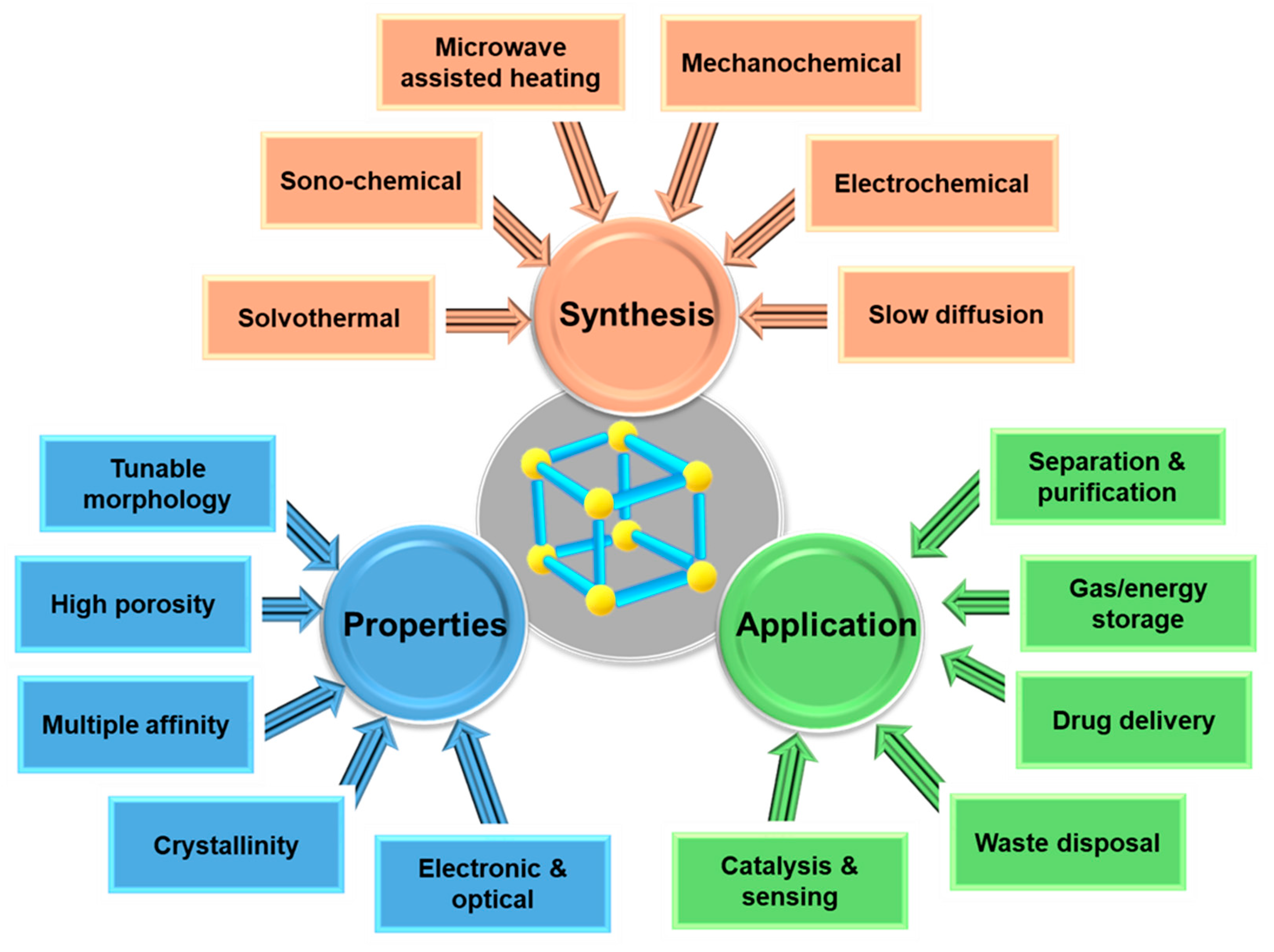
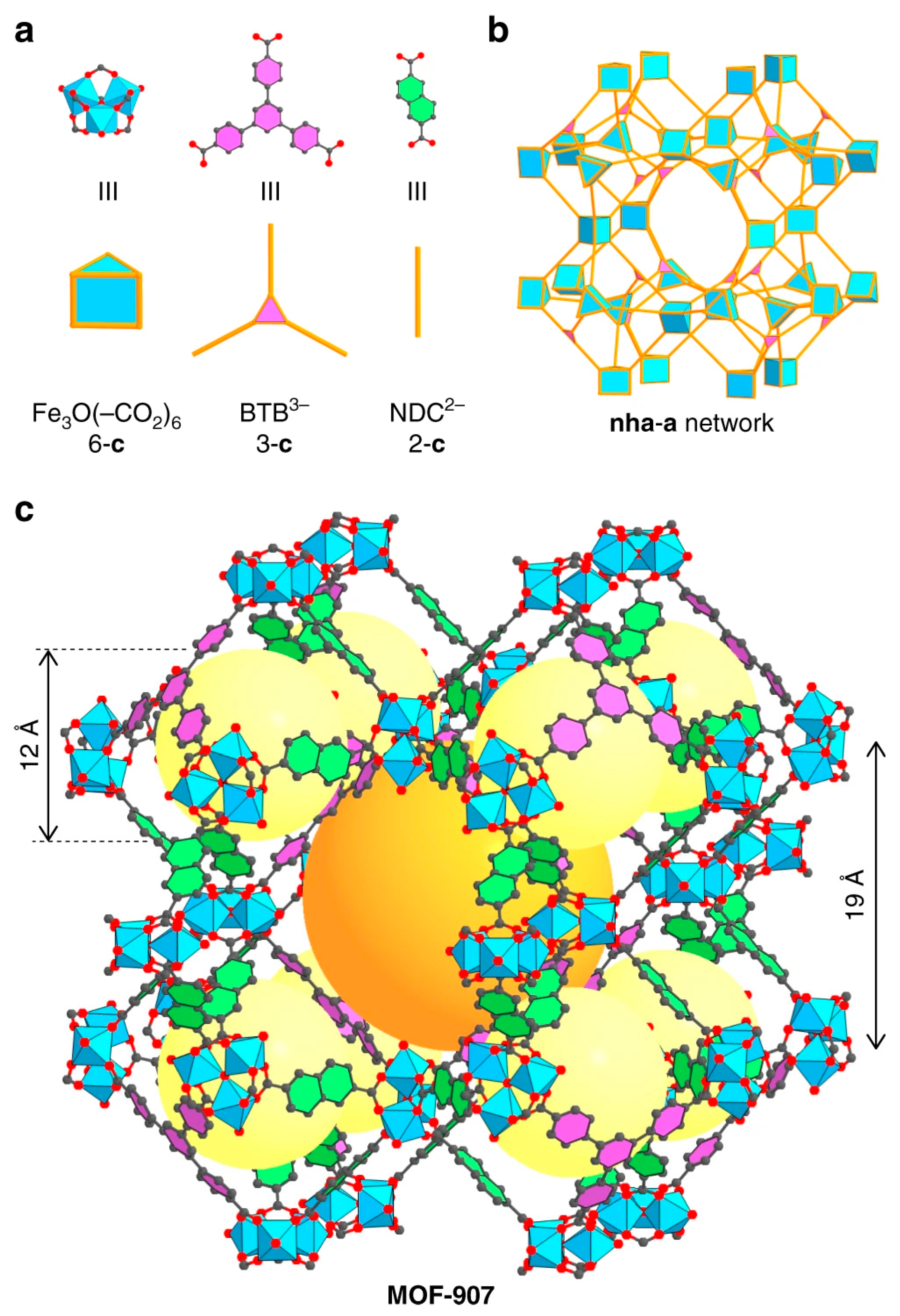

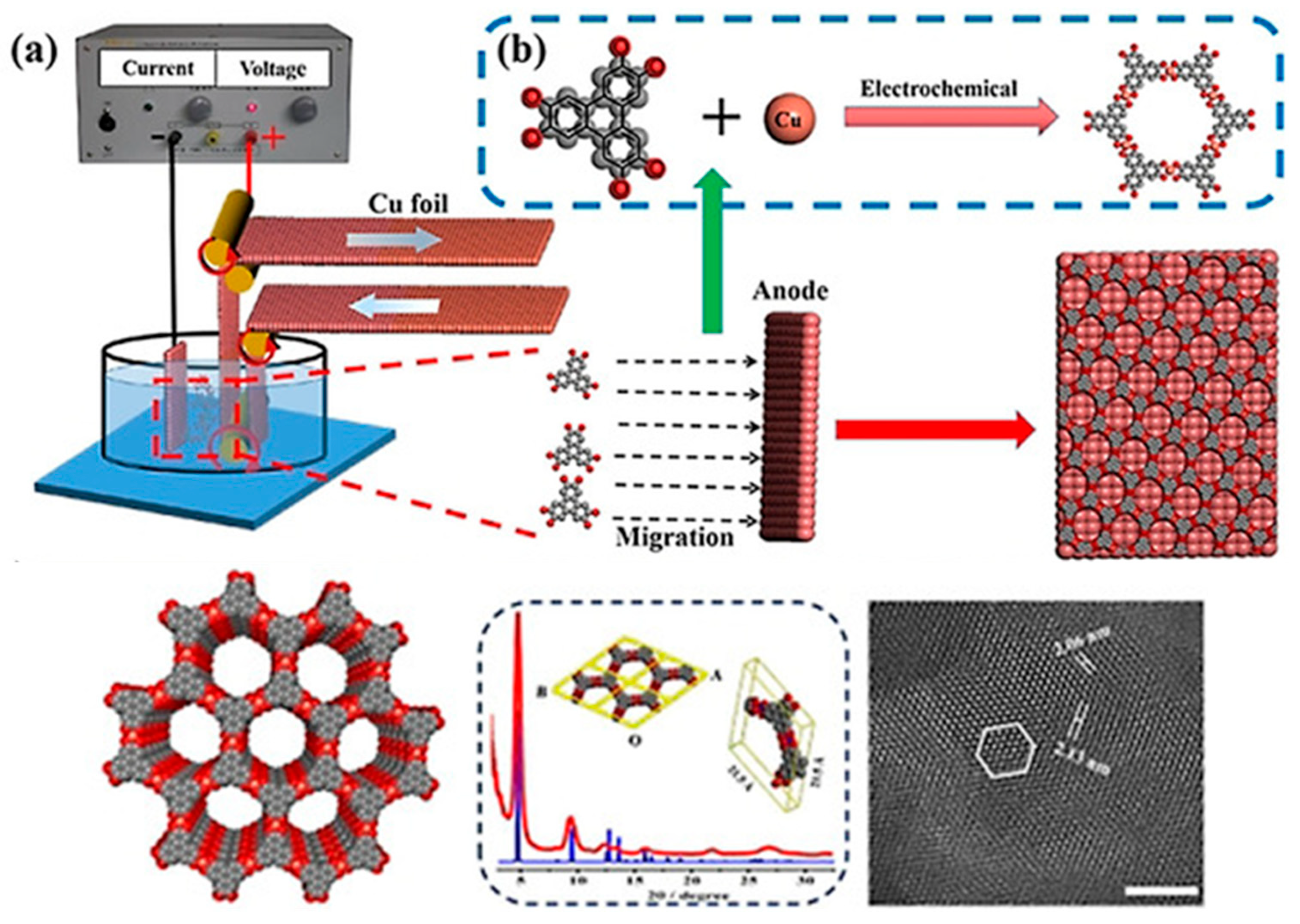
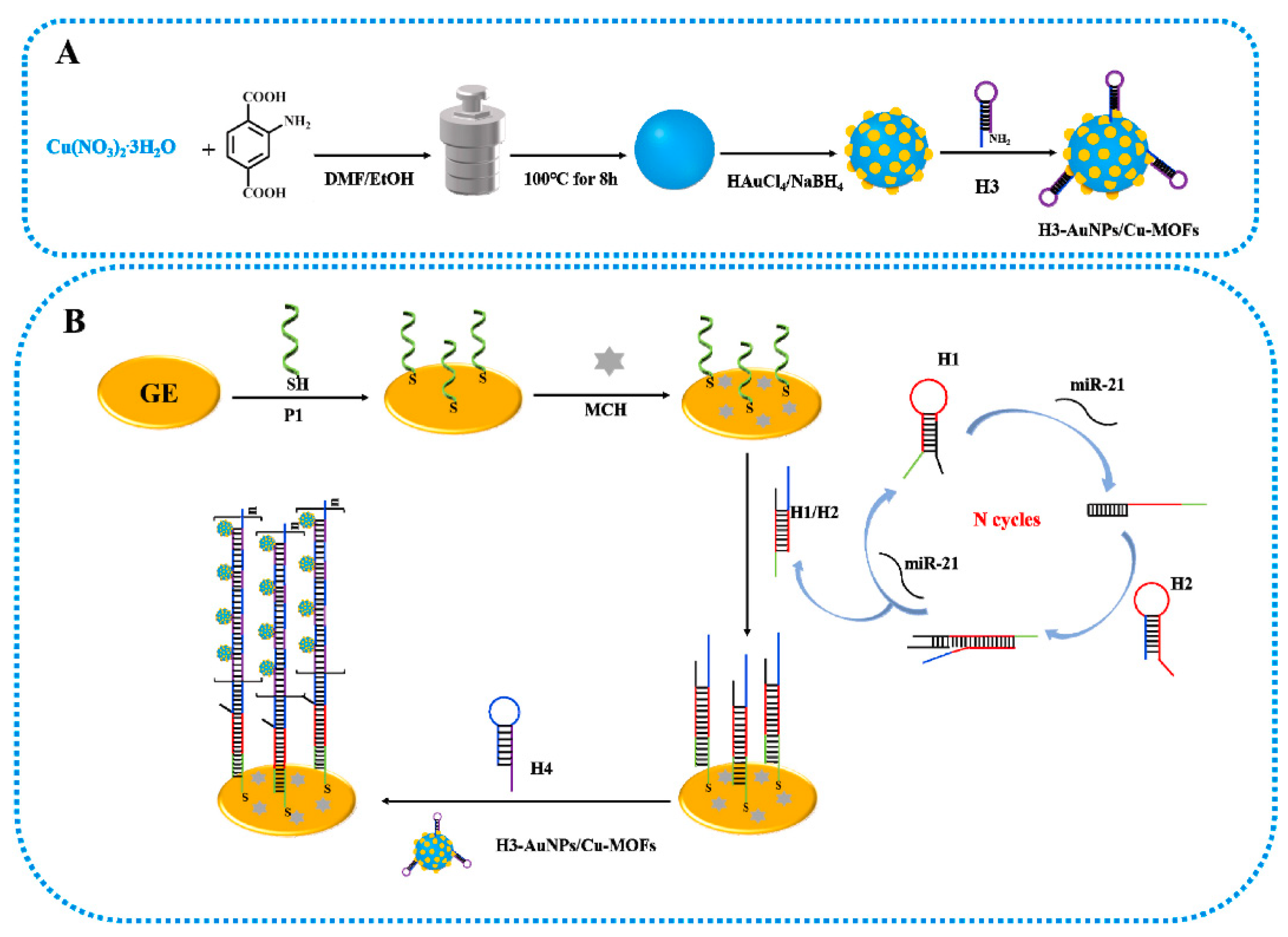
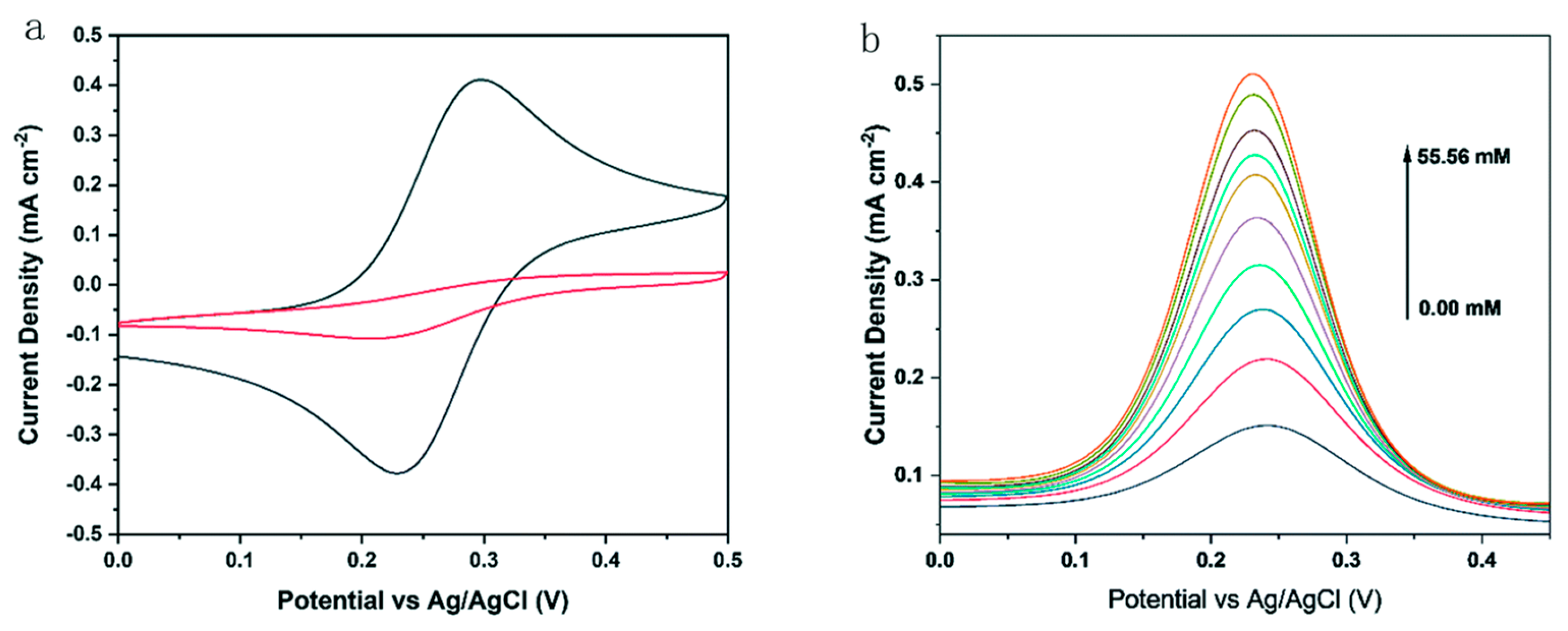
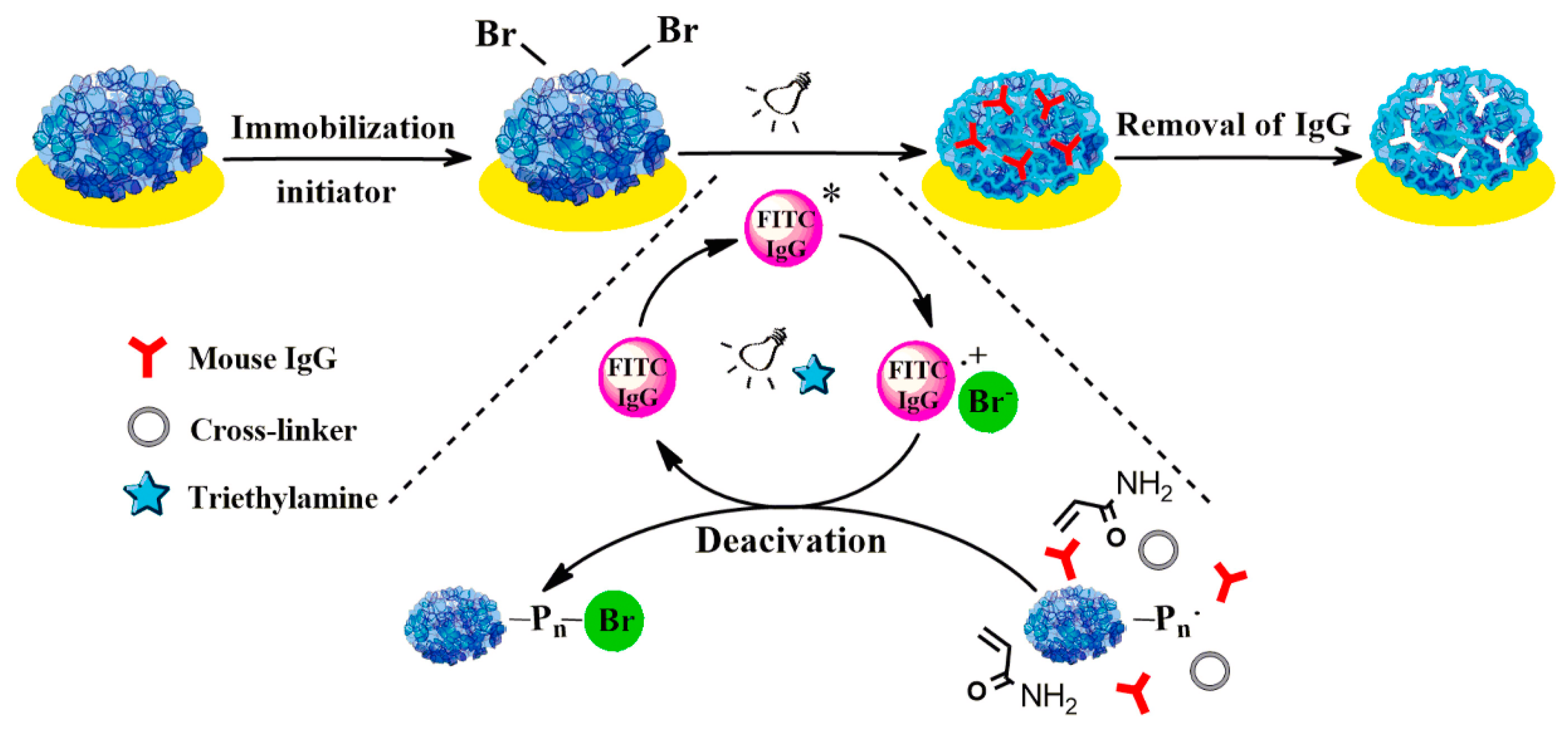
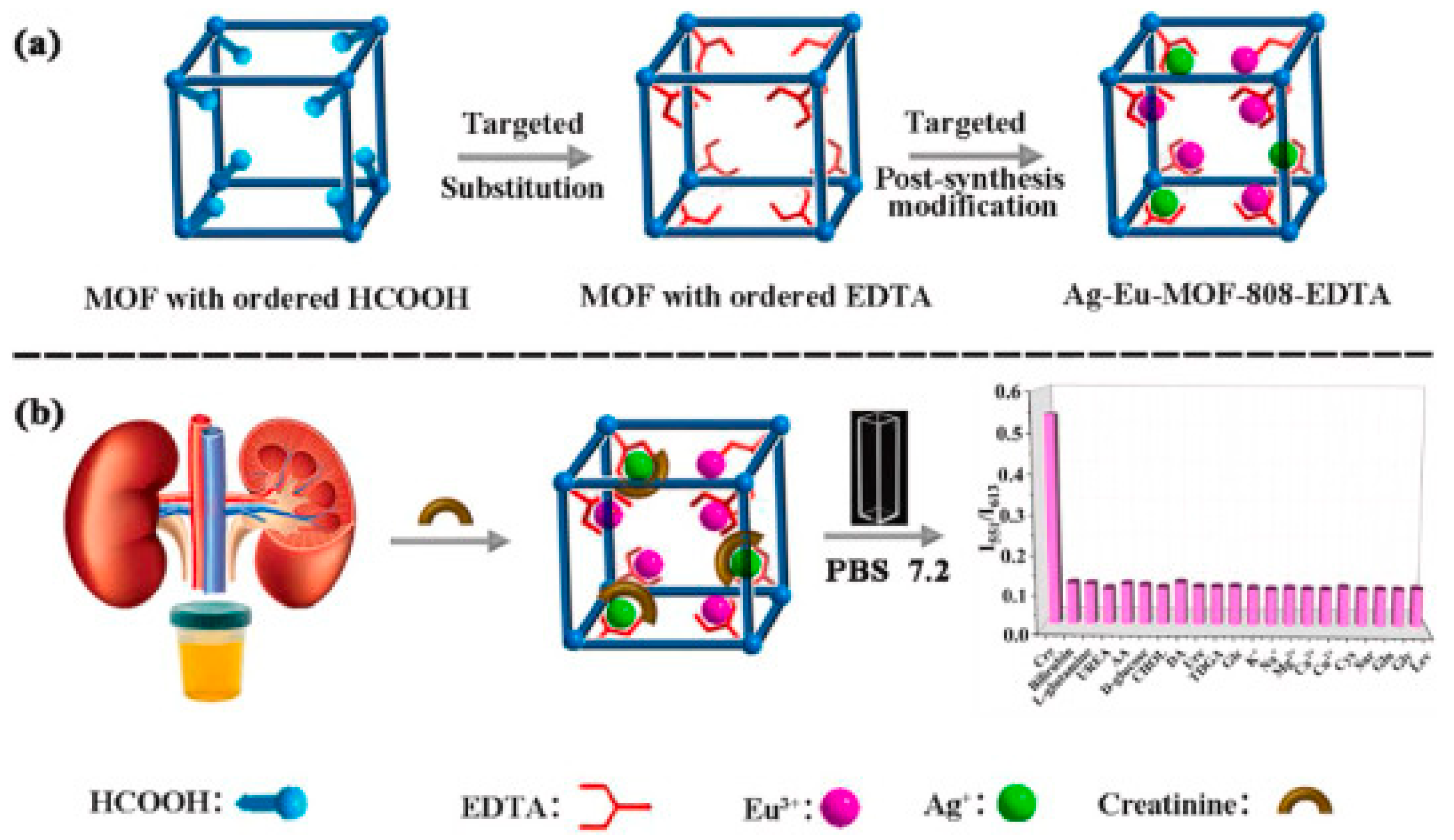
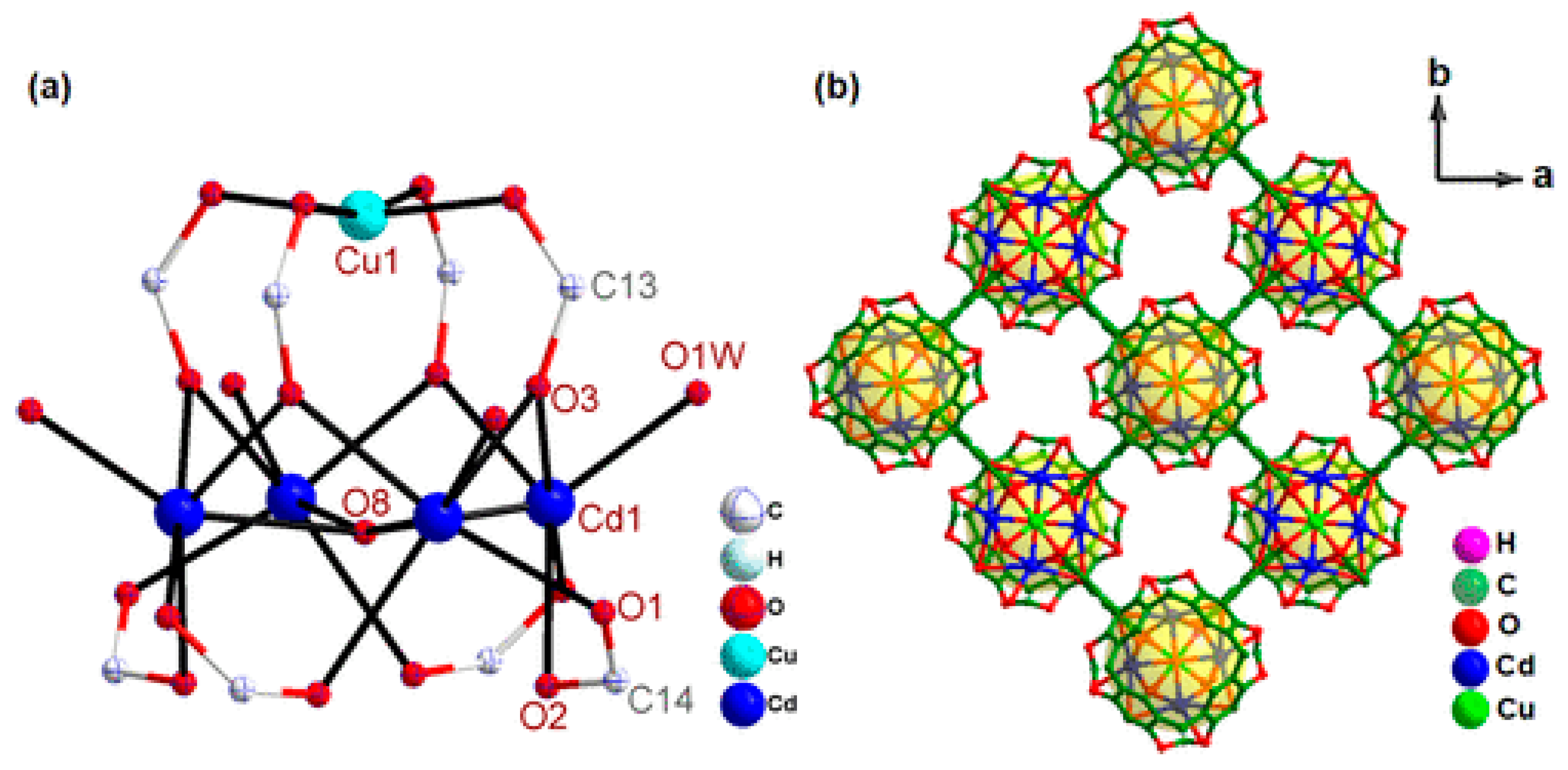

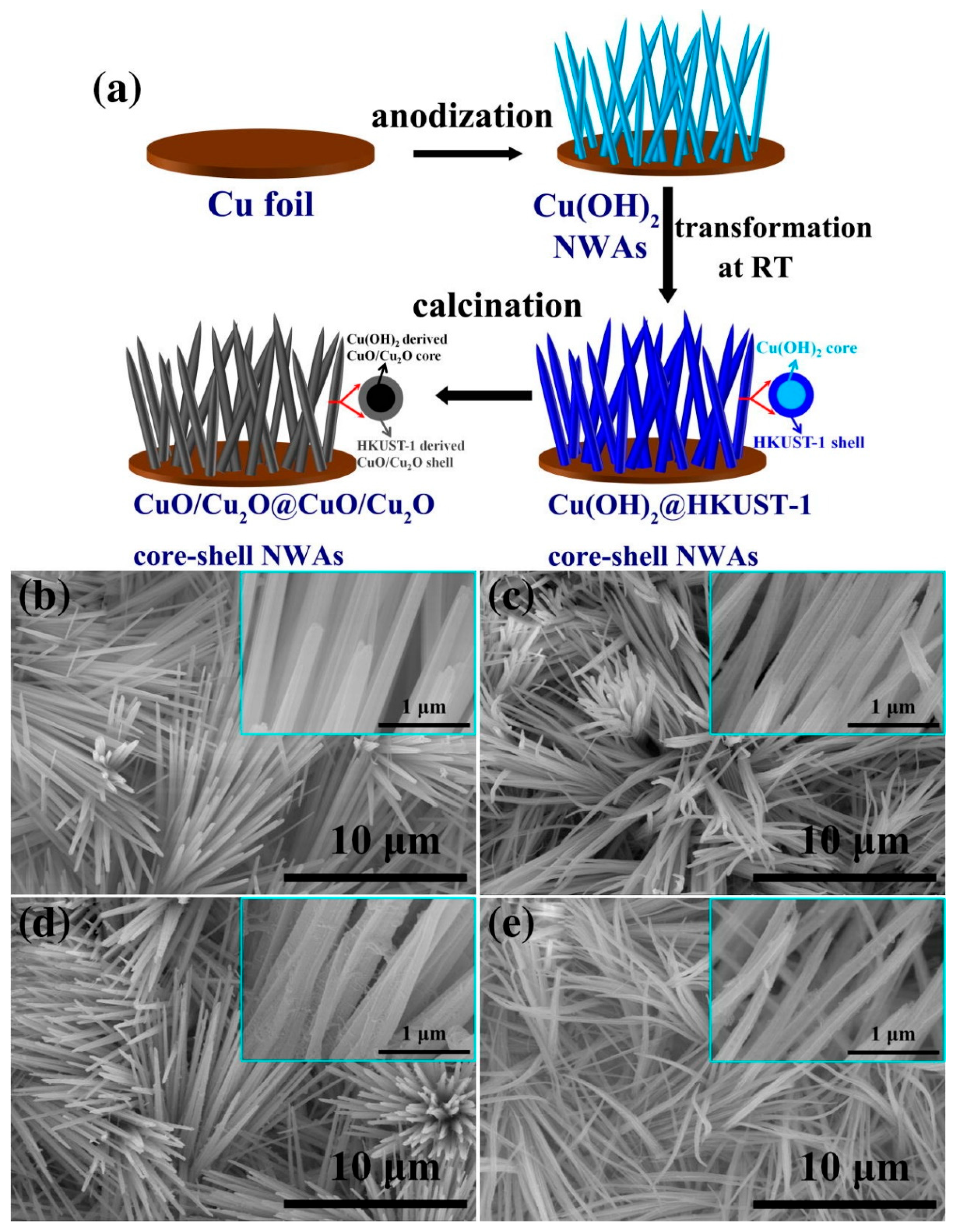

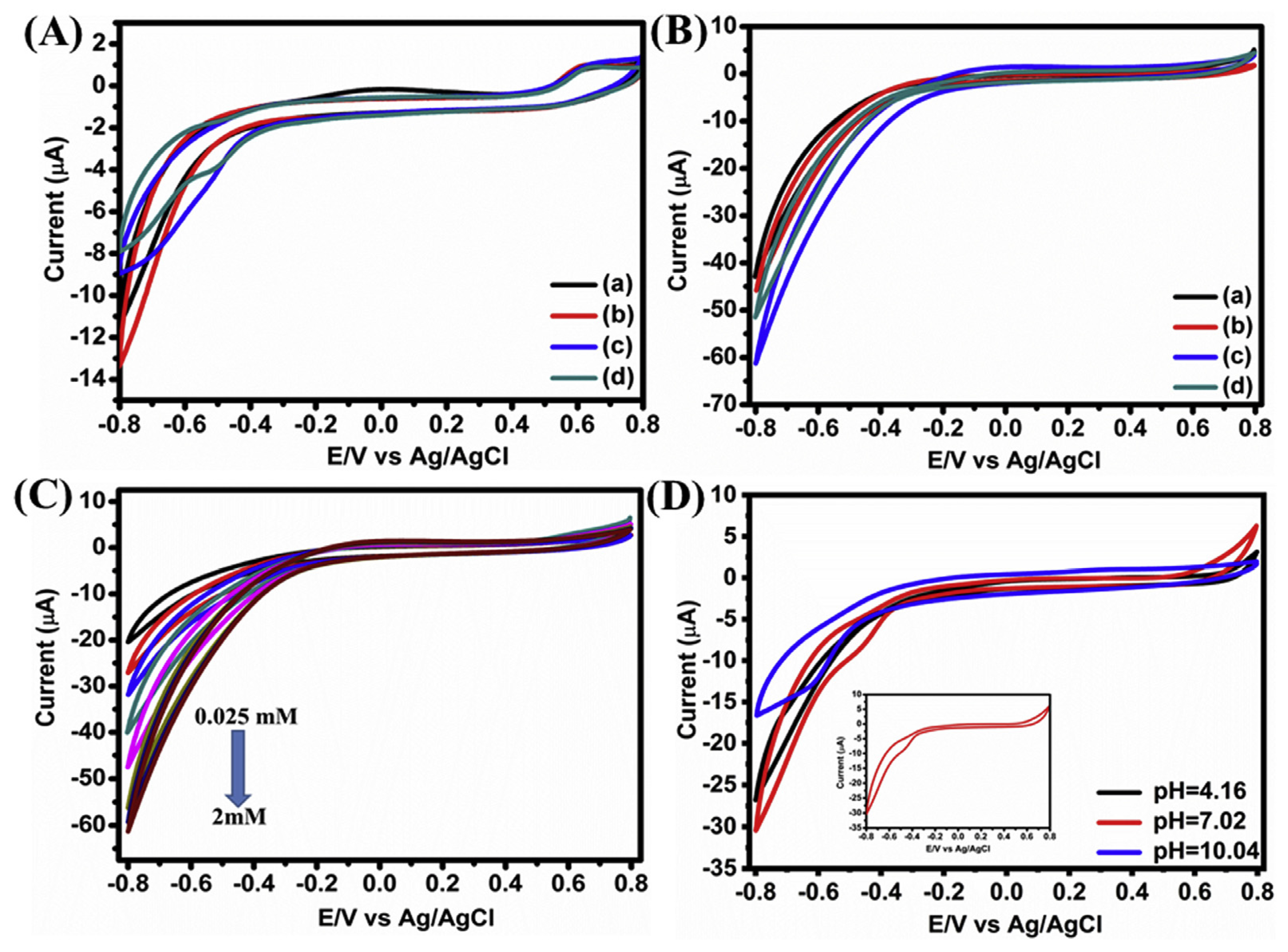
| Criteria | MOFs | Traditional Nanomaterials (e.g., CNTs, Nanoparticles) |
|---|---|---|
| Surface Area | High surface area, enhancing sensitivity and detection limit | Generally high but often lower than MOFs |
| Functionalization | Easy functionalization with various organic and inorganic groups | Functionalization is possible but can be complex and less versatile |
| Porosity | Highly porous, allowing for efficient molecule capture and transport | Variable porosity, often less tunable than MOFs |
| Stability | Can be less stable under certain conditions (e.g., moisture, pH) | Typically more stable and robust under various conditions |
| Toxicity | Generally low toxicity, though dependent on metal and organic linkers used | Potential for higher toxicity, depending on the material (e.g., CNTs can be cytotoxic) |
| Service Life | Potentially shorter due to sensitivity to environmental conditions | Generally longer service life due to robustness |
| Methods/Sensor | Target Analyte | Detection Limit (μM) | Sensitivity (μAcm−2 mM−1) | Recyclability | Ref. |
|---|---|---|---|---|---|
| GOD-GA-Ni/Cu-MOFs-FET | Glucose | 0.51 | 26.05 | - | [138] |
| PP/LIG | Glucose | 3 | 247.3 | 5 | [89] |
| Ru-PEI-L-lys-ZIF-8 | Thrombin | 2 × 10−14 | - | 5 | [126] |
| JUC-1000 | TNP | 3.46 × 10−17 | - | 7 | [139] |
| CuO/Cu2O@CuO/Cu2O | Glucose | 0.48 | 10,090 | 6 | [113] |
| CP1/GCE | Glucose | 80 × 10−7 | 517.36 | 3 | [85] |
| Poly-L-lysine | Glucose oxidase | 23 | 6.55 | - | [88] |
| GR/PANI-AuNPs(6 nm)-GOx/GOx | Glucose oxidase | 70 | 65.4 | 11 | [140] |
| Ag@ZIF-67 | Glucose | 0.66 | 0.379 | - | [141] |
| NiCo-MOF | Glucose | 0.29 | 6844.0 | 10 | [142] |
| Ni-MOF/CNTs | Glucose | 0.82 | 1385.0 | - | [143] |
| Cu-MOF-SWCNTs | Glucose | 0.0017 | 573 | - | [144] |
| HKUST3-1/KSC800 | Glucose | 4.8 | 28.67 | - | [145] |
| GOD/Cu-hemin MOFs | Glucose | 2.73 | 22.77 | - | [146] |
| Cu-MOF | Glucose | 0.01 | 89 | - | [147] |
| PdNP/PGaN | Glucose | 1.0 | 353 and 116 | 5 | [148] |
| MOCPsCu/Au | Glucose oxidase | 0.194 | 59 | - | [149] |
| MOF-71 | Uric acid | 15.61 | 0.4811 | - | [150] |
| ZIF-67 HNPs | Glucose | 0.96 | 445.7 | - | [151] |
| 3D N-Co-CNT@NG | Glucose | 0.1 | 9.05 | 10 | [152] |
Disclaimer/Publisher’s Note: The statements, opinions and data contained in all publications are solely those of the individual author(s) and contributor(s) and not of MDPI and/or the editor(s). MDPI and/or the editor(s) disclaim responsibility for any injury to people or property resulting from any ideas, methods, instructions or products referred to in the content. |
© 2024 by the authors. Licensee MDPI, Basel, Switzerland. This article is an open access article distributed under the terms and conditions of the Creative Commons Attribution (CC BY) license (https://creativecommons.org/licenses/by/4.0/).
Share and Cite
Kidanemariam, A.; Cho, S. Recent Advances in the Application of Metal–Organic Frameworks and Coordination Polymers in Electrochemical Biosensors. Chemosensors 2024, 12, 135. https://doi.org/10.3390/chemosensors12070135
Kidanemariam A, Cho S. Recent Advances in the Application of Metal–Organic Frameworks and Coordination Polymers in Electrochemical Biosensors. Chemosensors. 2024; 12(7):135. https://doi.org/10.3390/chemosensors12070135
Chicago/Turabian StyleKidanemariam, Alemayehu, and Sungbo Cho. 2024. "Recent Advances in the Application of Metal–Organic Frameworks and Coordination Polymers in Electrochemical Biosensors" Chemosensors 12, no. 7: 135. https://doi.org/10.3390/chemosensors12070135
APA StyleKidanemariam, A., & Cho, S. (2024). Recent Advances in the Application of Metal–Organic Frameworks and Coordination Polymers in Electrochemical Biosensors. Chemosensors, 12(7), 135. https://doi.org/10.3390/chemosensors12070135







